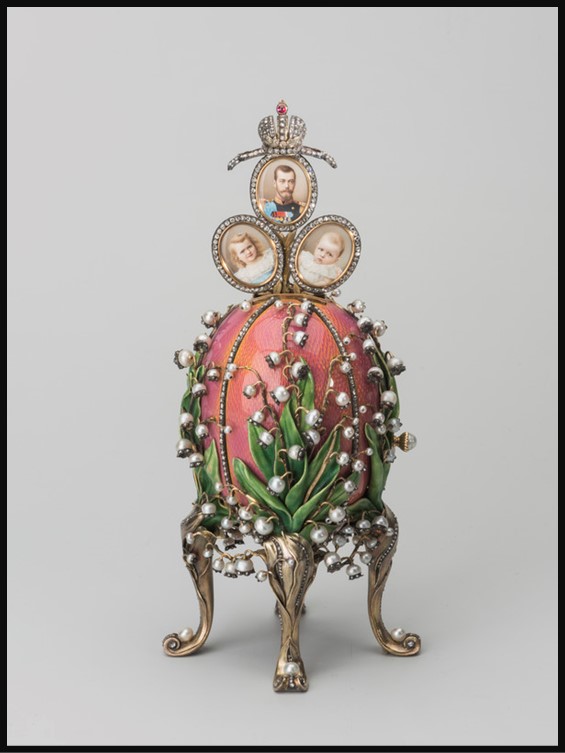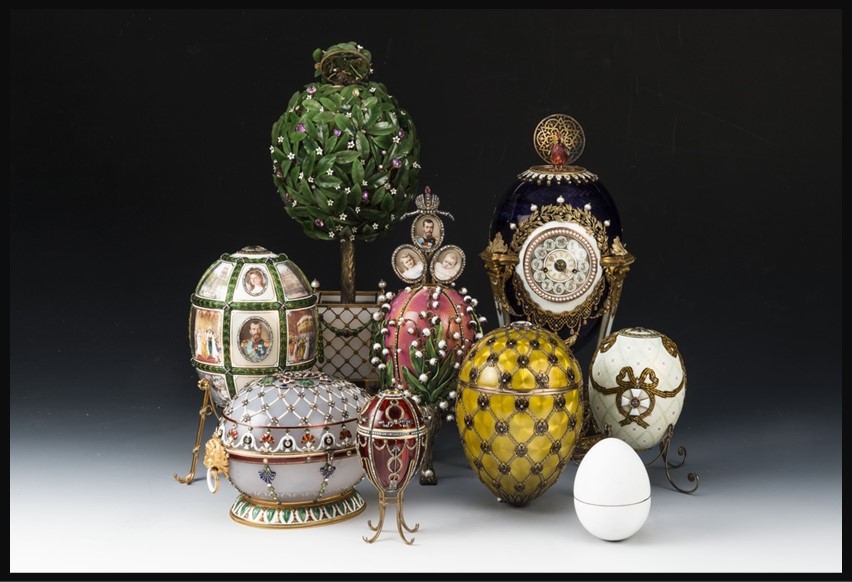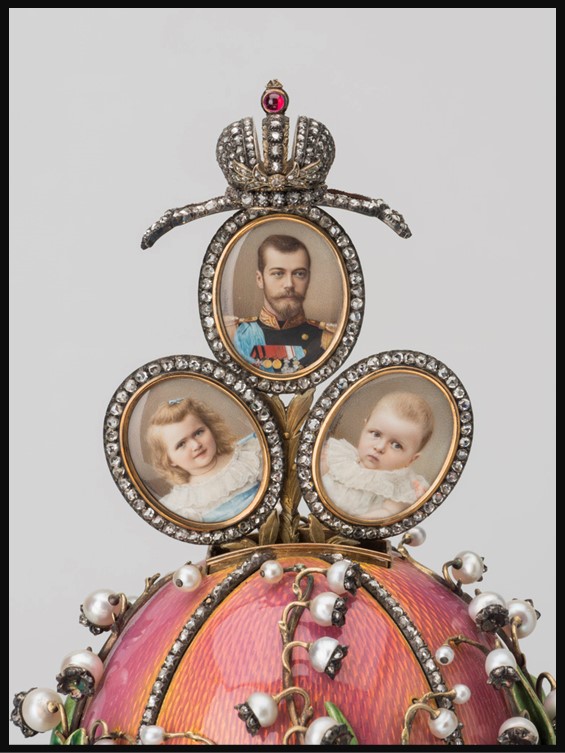
The Lilies of the Valley Fabergé Egg, 1898, Gold, Ruby, Rose-cut diamonds, Pearls, Ivory, Glass, Technics Casting, Embossing, Engraving, Guilloche enamel, Watercolor, Gilding, Height: 15,1 cm (opened: 19,9 cm), Fabergé Museum, Shuvalov Palace of Saint-Petersburg, Russia https://fabergemuseum.ru/en/collections/collection-highlights/lilies-of-the-valley-easter-egg
In the realm of art and beauty, William Blake, with his evocative poetry, reminds us on the one hand that… The modest Rose puts forth a thorn, / The humble sheep a threat’ning horn: / While the Lily white shall in love delight, / Nor a thorn nor a threat stain her beauty bright. Echoing this celebration of beauty and purity, on the other hand, Peter Carl Fabergé brings to life the unparalleled elegance of the lily in one of his most celebrated creations: The Lilies of the Valley Fabergé Easter Egg. https://en.wikipedia.org/wiki/The_Lilly_(poem)
Peter Carl Fabergé was a master jeweller and goldsmith of the Russian Empire, renowned for his exquisite and intricate craftsmanship, particularly in the creation of the famed Fabergé eggs. Born in Saint Petersburg in 1846 into a family of French Huguenot descent, Fabergé inherited his father’s jewelry business and elevated it to extraordinary heights of artistic and commercial success. He became most famous for the series of elaborately decorated Easter eggs he created for the Russian imperial family from 1885 to 1917. These eggs, crafted from precious metals and gemstones, were feats of engineering and artistry, containing surprises such as miniatures, clockwork birds, or ships. Fabergé’s work extended beyond these eggs to include a vast range of jewelry and luxury objects, admired for their beauty and precision. Despite the turmoil of the Russian Revolution, which eventually led him into exile, Fabergé’s legacy endures, symbolizing the pinnacle of craftsmanship and the opulence of pre-revolutionary Russia.
The Imperial Easter Eggs by Fabergé represent a highpoint in the world of art and craftsmanship, a series of 50 opulent, jewelled Eggs created for the Russian imperial family from 1885 to 1917. Commissioned initially by Tsar Alexander III as an Easter gift for his wife, Tsarina Maria Feodorovna, the tradition continued under his son, Nicholas II, who gifted them to his mother and wife. Each Egg, meticulously crafted from gold, enamel, and precious gems, concealed a unique surprise, ranging from miniature replicas of the imperial regalia to intricate mechanical objects, showcasing the unparalleled skill of Fabergé and his craftsmen. Beyond their artistic merit, these eggs held personal significance for the imperial family, commemorating events and anniversaries, and have become symbols of the extravagance of the Romanov dynasty and the lost opulence of Imperial Russia. Today, the surviving eggs are treasured as masterpieces of decorative art, housed in museums and private collections around the world, embodying the legacy of Fabergé’s genius and the enduring fascination with the Romanovs.

The Lilies of the Valley Fabergé Easter Egg, crafted in 1898, is the opulent gift given to Empress Alexandra Fyodorovna by Russia’s last Tsar, Nicholas II. This exquisite piece, designed by the renowned jeweler Peter Carl Fabergé, is adorned with translucent pink guilloché enamel on a gold base, vertical strips of rose-cut diamonds and pearl lilies of the valley elegantly accented with diamonds among green enamelled leaves. The Easter Egg is topped with a diamond and ruby-set Imperial crown, that hides a surprise, three miniature watercolour portraits, framed in diamonds, of Nicholas II and the two daughters of the royal family, Olga and Tatiana, in the form of a trefoil that opens when a pearl button is pushed. The Easter Egg is supported by cabriolet legs of graceful gold leaves adorned with pearls and sinuous lines of rose-cut diamonds.

The Lilies of the Valley Fabergé Egg (detail), 1898, Gold, Ruby, Rose-cut diamonds, Pearls, Ivory, Glass, Technics Casting, Embossing, Engraving, Guilloche enamel, Watercolor, Gilding, Height: 15,1 cm (opened: 19,9 cm), Fabergé Museum, Shuvalov Palace of Saint-Petersburg, Russia https://fabergemuseum.ru/en/collections/collection-highlights/lilies-of-the-valley-easter-egg
Lilies of the valley, symbols of purity, youth, and innocence, were the favourite flowers of Alexandra Feodorovna, who avoided “any kind of pomp” and dedicated almost all her time to her husband and children. They were also a favourite ‘motif’ of the Art Nouveau style, a movement that flourished in the late 19th and early 20th centuries, characterized by its focus on organic forms, intricate designs, and a harmonious integration of art with everyday objects. This Easter Egg exhibits several key characteristics of Art Nouveau, such as its graceful and asymmetrical form, which mimics the natural curves of the lilies of the valley. The use of enamel, a hallmark of Art Nouveau craftsmanship, adds vibrant colour and depth to the piece, while the incorporation of pearls and diamonds accentuates its luxurious appeal. Furthermore, the attention to detail, from the delicate placement of each gemstone to the subtle nuances in the design, reflects the meticulous craftsmanship synonymous with the Art Nouveau movement.
Renowned for its elegance and the intricacy of its design, the Lilies of the Valley Fabergé Easter Egg, encapsulates not just the unmatched skill of its creators but also the rich historical and emotional depth of the era it represents, making it a timeless testament to both the artistic innovations of its time and the enduring legacy of the Romanov dynasty. It epitomizes the Art Nouveau movement through its embodiment of organic beauty, exquisite craftsmanship, and the seamless fusion of art with functionality, while simultaneously serving as a symbol of imperial opulence, intricate artistry, and the poignant narrative of a bygone era.
As we welcome the 1st of May and with the Greek Orthodox Easter upon our threshold, I extend heartfelt Wishes to all for Health, Happiness, and the Warmth of shared moments with loved ones. Let the Lilies of the Valley Fabergé Easter Egg, an exquisite artefact that captures the essence of beauty and tradition, stand as a poignant reminder of the enduring spirit of rejuvenation, hope, and rebirth that Easter brings to many around the world.
For suggested Student Activities, please, Check… HERE!